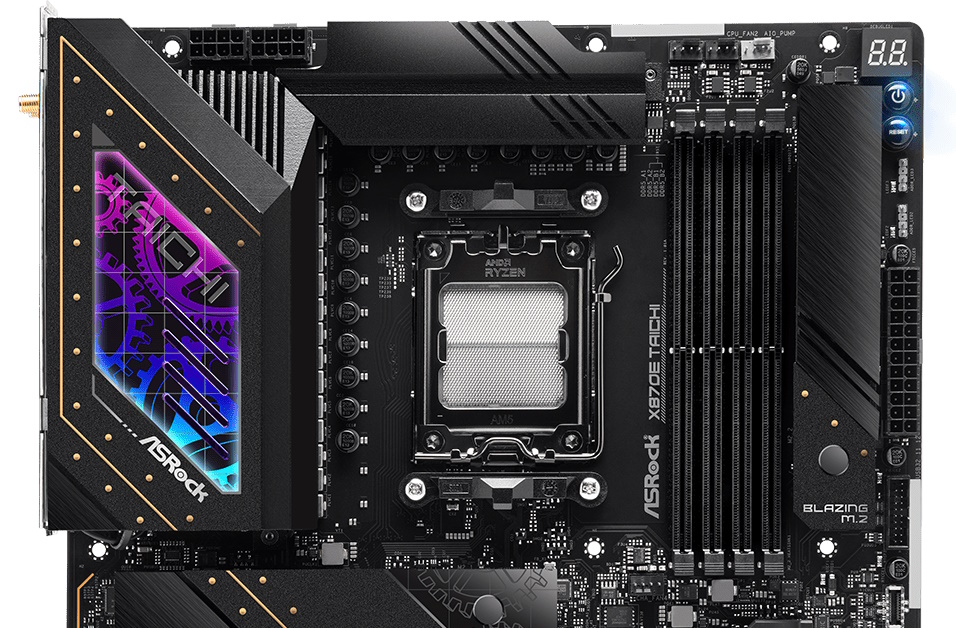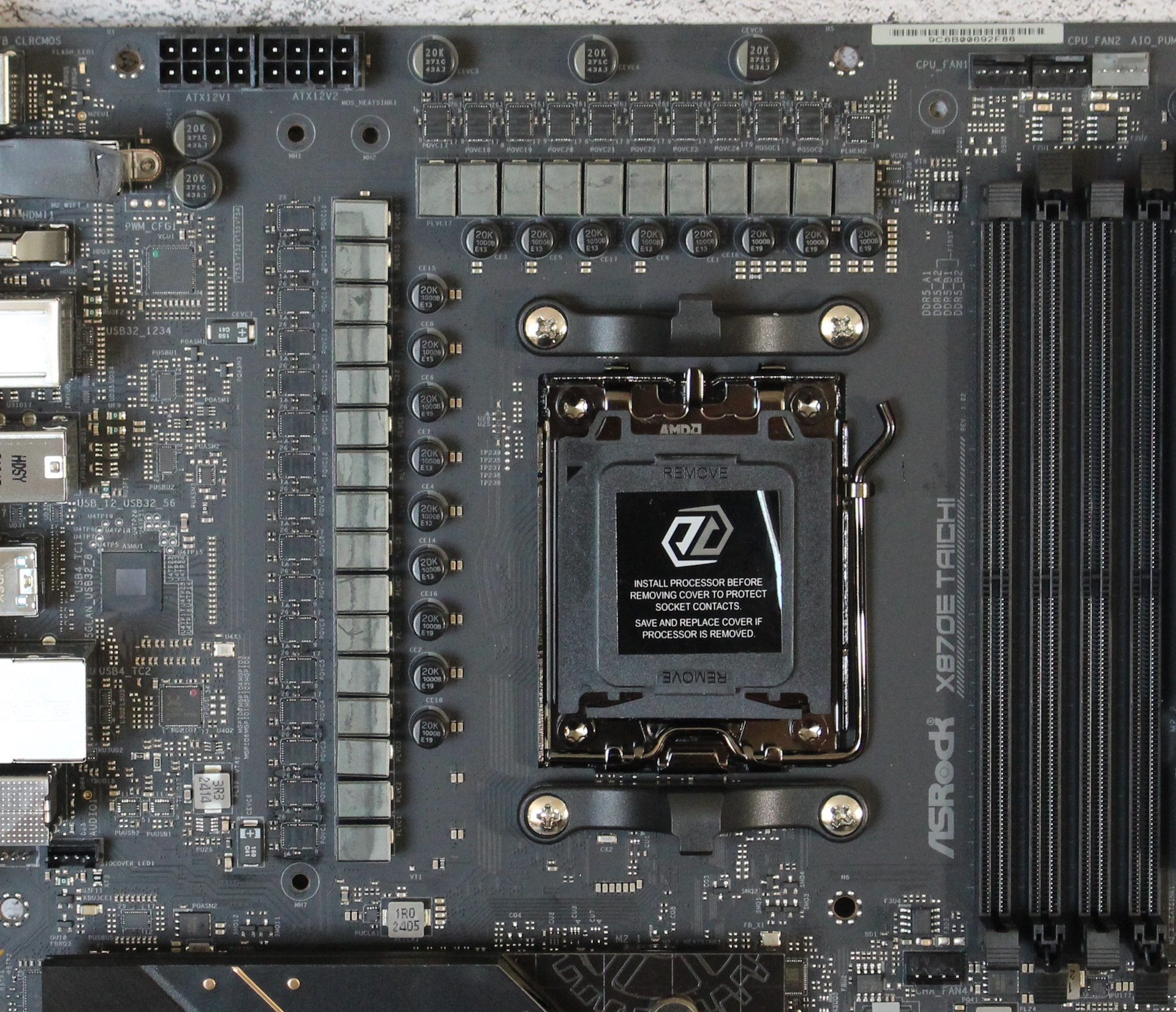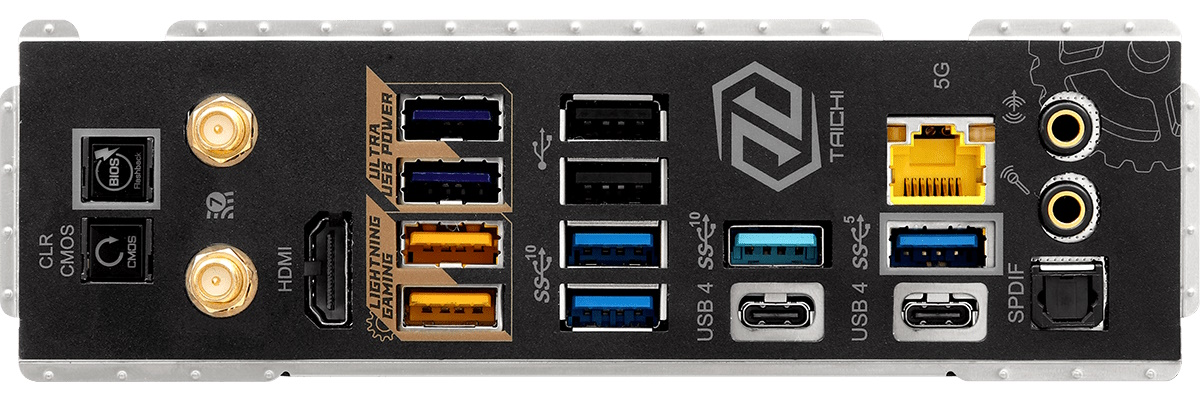Tom's Hardware Verdict
Priced $50 less than its direct competition, the ASRock X870E Taichi is not only a good value option for the current premium AMD board market, but it performs well, comes handsomely equipped, and has 12 total USB ports on the rear IO.
Pros
- +
Lower price than previous-gen X670E Taichi
- +
More DIY-friendly functions
- +
12 total USB ports on rear IO
Cons
- -
E-ATX will be too large for some
- -
More polarizing style than last-gen
Why you can trust Tom's Hardware
Previous iterations of ASRock’s Taichi motherboards (from both AMD and Intel camps) have impressed us as top values of the upper mid-range segment. These boards have tended to offer flagship-like features such as fast ports, robust power delivery, a premium appearance fitting for a high-end motherboard, and a palatable price. Fast-forward to today, and the ASRock X870E Taichi receives an updated design, more powerful VRMs, USB 4.0 (40 Gbps) Type-C ports again (now a standard for the platform), updated networking to 5GbE and Wi-Fi 7, and more. The best part? Its launch price is less than the previous-gen X670E Taichi that came out nearly two years ago.
ASRock’s product stack for AMD’s update X870/X870E chipset platform consists of seven boards at the time of publication. From the top down, there’s the Taichi ($499.99) and Taichi Lite ($399.99), X870E Nova WIFI ($349.99), X870E Riptide WIFI ($279.99), X870 Steel Legend WIFI ($259.99), and finally the Pro RS WIFI ($209.99) and Pro RS ($199.99). It’s a complete lineup, at least price/feature-wise, but I’d like to see Micro ATX and Mini-ITX options. Perhaps we’ll see that on the “B” series boards, whenever they release.
On the hardware front, the ASRock X870E Taichi has everything you’d expect from the platform. In addition to the dual USB 4.0 (40 Gbps) Type-C ports, you get 10 Type-A ports of varying speeds on the rear IO, two full-length PCIe 5.0 slots, a flagship-class audio solution with DAC, dual 2.5 and 5 GbE ports and Wi-Fi 7, four M.2 sockets (two with EZ-release latches), six SATA ports, active VRM cooling, and more.
The X870E Taichi performed well in our updated testing suite and with the Ryzen 9 9900X processor. From our first batch of testing, the Taichi and Gigabyte’s Aorus Master traded podium spots in the productivity tests and also showed off their grit in gaming. The Taichi's default settings let any installed CPU reach its potential.
Below, we’ll examine the board's details and determine whether it deserves a spot on our Best Motherboards list. But before we share test results and discuss details, we’ll list the specifications from ASRock’s website.
Specifications of the ASRock X870E Taichi
Socket | AM5 (LGA 1718) |
Chipset | X870E |
Form Factor | E-ATX |
Voltage Regulator | 27 Phase (24x 110A SPS MOSFETs for Vcore) |
Video Ports | (2) USB 4 (Type-C) |
| Row 5 - Cell 0 | (1) HDMI (v2.1) |
USB Ports | (2) USB 4.0 (40 Gbps) Type-C |
| Row 7 - Cell 0 | (5) USB 3.2 Gen 2 (10 Gbps) |
| Row 8 - Cell 0 | (3) USB 3.2 Gen 1 (5 Gbps) |
| Row 9 - Cell 0 | (2) USB 2.0 (480 Mbps) |
Network Jacks | (1) 5 GbE |
| Row 11 - Cell 0 | (1) 2.5 GbE |
Audio Jacks | (2) Analog + SPDIF |
Legacy Ports/Jacks | ✗ |
Other Ports/Jack | ✗ |
PCIe x16 | (1) v5.0 (x16/x8) |
| Row 16 - Cell 0 | (1) v5.0 (0x/x8) |
PCIe x8 | ✗ |
PCIe x4 | ✗ |
PCIe x1 | ✗ |
CrossFire/SLI | AMD Crossfire |
DIMM Slots | (4) DDR5-8200+(OC), 256GB Capacity |
M.2 Sockets | (1) PCIe 5.0 x4 (128 Gbps) / PCIe (up to 80mm) |
| Row 23 - Cell 0 | (3) PCIe 4.0 x4 (64 Gbps) / PCIe (up to 80mm) |
| Row 24 - Cell 0 | (Supports RAID 0/1/10) |
SATA Ports | (6) SATA3 6 Gbps (Supports RAID 0/1/10) |
USB Headers | (1) USB v3.2 Gen 2x2 (20 Gbps) Type-C |
| Row 27 - Cell 0 | (2) USB v3.2 Gen 1 (5 Gbps) |
| Row 28 - Cell 0 | (2) USB v2.0 (480 Mbps) |
Fan/Pump Headers | (8) 4-Pin (CPU, Chassis, AIO, Water Pump) |
RGB Headers | (3) aRGB Gen 2 (3-pin) |
| Row 31 - Cell 0 | (1) RGB strip (4-pin) |
Diagnostics Panel | (1) Dr. Debug 2-character Debug LED |
Internal Button/Switch | (1) Power button |
| Row 34 - Cell 0 | (1) Reset button |
SATA Controllers | ✗ |
Ethernet Controller(s) | (1) Realtek 8126 (5 GbE) |
Wi-Fi / Bluetooth | Wi-Fi 7 - 160 MHz, 6 GHz, BT 5.4 |
USB Controllers | ASMedia ASM4242 |
HD Audio Codec | Realtek ALC4082 w/ESS Sabre9219 DAC |
DDL/DTS | ✗ / ✗ |
Warranty | 3 Years |
Inside the Box of the ASRock X870E Taichi
ASRock includes a few accessories to get you going. This includes SATA cables, the Wi-Fi antenna, three thermistor cables, and an ARGB splitter. Compared to some others around this price point, you don’t get a lot of extras, but it’s not missing anything major, either.
Design of the Taichi



Like all X870/X870E-based boards, the X870E Taichi also receives aesthetic updates. The board is still on a black, server-grade, 8-layer PCB with 2 Oz. of copper and uses an extra-large heatpipe-connected heatsink on the VRMs and PCIe 5.0-capable M.2 socket. Design-wise, the famous cog/gears aesthetic (“Philosophy of Infinite Potential”) is still prominent, with the focal point an RGB illuminated area (controlled through Polychrome Sync) on the left VRM heatsink with the cogs shining through. Brushed aluminum finishes grace most surfaces, along with the curious addition of gold dots. I could do without it, but it’s still a good-looking board, even compared to the competition.
Get Tom's Hardware's best news and in-depth reviews, straight to your inbox.
Our trip around the board starts in the left corner, where we run into two (one required) 8-pin EPS connectors for powering the processor. The “XXL” VRM heatsink is also actively cooled with a tiny fan hidden underneath. Thankfully, we couldn’t hear it over ambient room noise and other fans during testing. On top is the RGB feature with the gears and the ASRock name in white.
Moving past the socket area, we first encounter the four DRAM slots with locking mechanisms on both sides. The unreinforced DRAM slots support up to 256GB of RAM with speeds listed to DDR5-8200+(OC). Like the MSI and Gigabyte X870 boards we covered, the Taichi could boot with our DDR5-8000 kit but couldn’t run the stress test with out-of-the-box settings. Again, Klevv kits were on the memory QVL (Hynix-M die) but not our DDR5-8000 kit (Hynix A-die). Stick to the QVL list and you shouldn’t have many issues getting RAM to work at their rated speeds.
Above the DRAM slots are the first three (of eight) 4-pin fan headers. Each header supports PWM- and DC-controlled devices, and plenty of power is available on these headers. The CPU fan has the least at 1A/12W, but the rest are 3A/36W. The BIOS or the Blazing OC Tuner software handles control over these devices.
Next, in the upper-right corner, is the Dr. Debug LED that displays POST codes during boot and temperatures while in Windows. Below are the power and reset buttons and our first two 3-pin ARGB connectors. Control over the integrated and any attached RGB lighting is managed through the ASRock Polychrome RGB application. Continuing down the right edge is the 24-pin ATX connector to power the board and two USB headers (19-pin USB 3.2 Gen2 and USB 3.2 Gen 2x2 Type-C connector). Running vertically in this area is one of the M.2 sockets that includes a toolless heatsink.
Power delivery on the X870E Taichi is one of the most capable, consisting of 27 phases (24 to Vcore). Power moves from the EPS connector(s) to a Renesas RAA229628 20-phase controller. The next hop is to the 24 Renesas R2209004 SPS MOSFETs in a ‘teamed’ or ‘dual’ configuration. The 2,640 Amps available is one of the highest values we’ve recorded and surely won’t get in the way of overclocking, including extreme overclocking using sub-ambient cooling methods. You’re limited by cooling only.
On the bottom half of the board, starting on the left, is a mostly exposed audio section based around the flagship Realtek ALC4082 codec and the ESS Sabre9219 DAC. You can also see the audio separation line and four red WIMA audio capacitors peeking out from below an M.2 heatsink. This is one of the better audio implementations you’ll see on the platform without a separate DAC.
The middle of the board houses the two reinforced PCIe slots and three of the four M.2 sockets. Starting with the full-length PCIe slots, both connect through the CPU and run PCIe 5.0. The top slot sports the graphics card EZ release runs up to x16 and breaks down to x8/x8 when the bottom slot is populated. There isn’t much room for expansion, but there’s plenty of bandwidth.
Three M.2 sockets mix in around the PCIe slots, with the top slot using the largest (and toolless!) heatsink for the only PCIe 5.0-capable M.2 socket. The bottom two M.2 sockets run on the chipset and a maximum of PCIe 4.0 x4 speeds. All key-M M.2 sockets support up to 80mm modules (the other M.2 is key-e and 30mm for the Wi-Fi by the rear IO). If you’d like additional throughput or redundancy, the Taichi supports RAID 0/1/10 modes for the NVMe drives. Just past the chipset heatsink on the right edge are six horizontal SATA ports supporting RAID 0/1/10 modes. There are plenty of storage options available.
Across the bottom of the board are several exposed headers. You’ll find the usual, including additional USB ports, RGB headers, and more. Below is a complete list, from left to right.
- Front panel audio
- 4-pin RGB header
- 3-pin ARGB header
- (3) 2-pin temperature headers
- (2) USB 2.0 headers
- (4) System fan headers
- 19-pin USB 3.2 Gen 1 connector
- 2-pin Clear CMOS jumper
- Power LED and Speaker header
- Front panel
Working our way to the backplate on the X870E Taichi, we see an area packed with connectivity. Sporting a black background and grey text, it’s relatively easy to read, and the labels are descriptive, so we can’t ask for much more. In the middle are a whopping 12 total USB ports, including 2x USB 4.0 (Type-C - also supports video via DisplayPort), 5x USB 3.2 Gen 2 (10 Gbps), 3x USB 3.2 Gen 1 (5 Gbps) and 2x USB 2.0). Flanking them on the left are an HDMI output, the standard Wi-Fi 7 antenna connectors, Clear CMOS and BIOS Flashback buttons. The audio stack has two 3.5mm jacks (microphone and output) and an SPDIF connection on the right. Last, to the left of the audio, is the 5 GbE port.
MORE: Best Motherboards
MORE: How To Choose A Motherboard
MORE: All Motherboard Content

Joe Shields is a staff writer at Tom’s Hardware. He reviews motherboards and PC components.
-
Jame5 ReplyThe CPU fan has the least at 1A/12W, but the rest are 3A/36W.
Seriously question: What kind of fans require 36w of power to drive in a desktop configuration? -
Notton Reply
It's for when you want to plug in 6 fans into the same header for a 360mm radiator in push-pull.Jame5 said:Seriously question: What kind of fans require 36w of power to drive in a desktop configuration?
or they figured the user is too dumb and will plug in their AIO pump into the header.
or it was cheaper/simpler to use the same circuit design for both fans and pumps, but then IDK why the CPU fan header only supports 12W. -
Jame5 ReplyNotton said:It's for when you want to plug in 6 fans into the same header for a 360mm radiator in push-pull.
or they figured the user is too dumb and will plug in their AIO pump into the header.
or it was cheaper/simpler to use the same circuit design for both fans and pumps, but then IDK why the CPU fan header only supports 12W.
Fair enough. I guess I'm officially old now.
I always thought it was bad to try and drive multiple fans from a single fan header. I guess times have changed and they've figured that out. This would also explain how a motherboard could manage and drive one of those fan breakout boards in the new cases I've been looking at. Like this shot from the Be Quiet review last week:
Although looking at it, it has a separate power and mb_sync connection on it. So I really don't understand anything.
-
HideOut Today we are happy that a motherboard is only $450. It doesnt come with 10GbE and its $450. But hey, if you click on links THG gets a cut.Reply -
castl3bravo X870E (versus X670) consumes another PCIE x4 lane for a 40Gig USB4 interface. What can you get that will consume that bandwidth?Reply -
AkroZ Reply
A USB hub with 2 x 4K 60 Hz monitors, network, mouse and keyboard.castl3bravo said:X870E (versus X670) consumes another PCIE x4 lane for a 40Gig USB4 interface. What can you get that will consume that bandwidth?
For more go Thunderbolt 5 with 80Gig. -
ddcservices Reply
This isn't a tiny ITX motherboard, so why bother with a dock, unless you are in an unusual situation where you move your desktop machine from location to location on a very regular basis? The majority will plug their stuff directly into the motherboard. If anything, I'd love to see more video cards with USB-C output to handle dual-monitor setups.AkroZ said:A USB hub with 2 x 4K 60 Hz monitors, network, mouse and keyboard.
For more go Thunderbolt 5 with 80Gig.
Laptops are where most people who need better connectivity will go with a dock, but also because laptops are designed to be portable.





